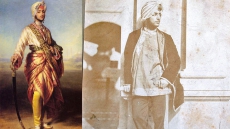TORONTO — After the matriarch died last year, a vicious battle erupted among the female baboons at the Toronto Zoo for her throne that endured for months, prompting a brief closure of the exhibit and providing a fascinating glimpse into the animals' behaviour.
Medical records show numerous injuries among five of the six female olive baboons, from deep lacerations near their eyes to hair ripped out and tail injuries. At least two required surgeries to close deep gashes.
The exhibit was closed for several days because "there were some injuries that we thought best to keep them at the back because our visiting public don't know baboon behaviour," said Maria Franke, the curator of mammals at the zoo.
The baboon house — the area not open to the public where the animals eat and sleep — also had to be modified to allow for more space and additional escape routes, Franke said.
Chris Dutton, the zoo's senior veterinarian, said the animals are fine and are "incredibly tough and they heal incredibly well."
Now, Dutton said, two females sit on the throne in an uncomfortable truce, with the rightful heir biding her time until the older one dies.
Baboons, both in the wild and at zoos, have societies that are run by females — and that dominance runs through family lines. So the oldest daughter of the matriarch is the rightful heir to become queen.
That's what happened to Betty, the longtime queen of the 12-member troop who took the reins when her mother, Boss Lady, died.
But troubles began a year ago when keepers noticed differences in Betty's behaviour, Franke and Dutton said.
"She was changing her naturally dominant behaviour and she was hanging out with the subordinates and starting to slow down a little," Dutton said.
The medical records, obtained via freedom-to-information legislation, note Betty was "reported to be lethargic, losing weight and not eating well."
By early December, Betty stopped eating.
So Dutton and his staff anesthetized her to figure out what was going on. An exploratory surgery revealed a tumour in her uterus that had spread to the abdominal wall. It was terminal, Dutton said, so they euthanized her on the operating room table on Dec. 5, 2014. She was 16 years old.
That's when the brawling began.
Molly is Betty's oldest daughter and baboon society dictates the throne was hers. But she was young at six years old, and not fully mature.
So Putsie, who at 18 years old is the enclosure's oldest female, saw an opportunity.
"She's fighting to be dominant because of age, I guess," Franke said.
It's unclear exactly who inflicted which wounds on whom, as the attacks happened mostly at night and away from the keepers. But over the course of the following year, Putsie had only one minor injury, while the remaining five animals fared worse.
Molly and her sister, Susan, appeared to suffer the most attacks early on, according to the medical records.
Molly was attacked at least eight times over the course of three months. At one point, her left eye was swollen shut and she had deep lacerations above both eyes and a gash to the bone on her nose, the records show. Molly was anesthetized and one wound was stitched up.
By mid-month, Susan was attacked and suffered "severe lacerations" of the right side of her face that left the orbital bone exposed. The injury required surgery similar to Molly's.
The eye itself wasn't affected, the records say, "but the eye remains semi closed before and after suturing and cannot rule out muscle or nerve damage to peri-orbital structures."
Three subordinate females, Kristina, Kate and Kalamata — all Putsie's daughters — were also attacked. Kristina's left eye was swollen shut after a fight, according to the medical records.
Kate had cuts on her face and several bites to her tail.
"Now all the aggression is occurring to the other animals, the least dominant, which is Kalamata," Franke said.
On Feb. 3, Kalamata was attacked — the same night as Kate.
"Most of the hair on top of her head has been ripped out," the medical notes read. "This individual has been attacked multiple times within the last two months."
She was attacked again this past October, Dutton said, when one baboon bit her tail.
Dutton and Franke only intervened when a baboon needed medical treatment. They were loathe to interrupt the baboon's own game of thrones.
"You have to let their natural behaviour happen," Franke said. "They have to sort it out. In the wild, a lot of times it's to the death."
She added a baboon has never been killed by another baboon at the Toronto Zoo.
A veterinary note that was attached to several baboons' medical files suggests various interventions, including modifying the enclosure to add outdoor heaters and shelters so that the animals can have outdoor access at night without freezing.
The note also suggests looking into medical options for regulating aggressive behaviour.
As for medical intervention, Dutton said: "We don't particularly want our animals on some form of mood-altering drugs of any kind because we don't think that's appropriate."
Earlier this week, the baboons lounged in the sun grooming each other and lazing around. Kalamata lay on a rock, a portion of her tail scabbed over.
The only drama came when one male made a sexual play for a female. Bwana Joe, the oldest and largest male, took offence and chased several baboons up the rock wall — but eventually succeeded in wooing one of the females himself.




